page 21
~ The Study of Threes ~
http://threesology.org
| Hybrids page 1 | Hybrids page 2 | Hybrids page 3 | Hybrids page 4 | Hybrids page 5 |
| Hybrids page 6 | Hybrids page 7 | Hybrids page 8 | Hybrids page 9 | Hybrids page 10 |
| Hybrids page 11 | Hybrids page 12 Playmate God |
Hybrids 13 Economics 1 |
Hybrids 14 Economics 2 |
Hybrids 15 Economics 3 |
| Hybrids 16 Economics 4 |
Hybrids 17 Economics 5 |
Hybrids 18 Economics 6 |
Hybrids 19 Economics 7 |
Hybrids 20 Language 1 |
| Hybrids 21 Language 2 |
Hybrids 22 Language 3 |
Hybrids 23 Language 4 |
Hybrids 24 Physics |
Hybrids 25 |
| Hybrids 26 | Hybrid 27 |
Visitors as of 30th July, 2021

As an aside reference to commonly overlooked sounds describing everyday symbols, we can speak of numbers and letters of the alphabet, in this case, the English alphabet. For example, each of the numbers one through ten have a different sound. If we include "zero" we have a tenth individual sound, even though during the development of numbers there were combinations such as the repetition of "teen" for the seven teens: 13,14,15,16,17,18,19. If we exclude the word zero, one can reference it metaphysically as "state of being". It is a sound which also is different, but because it is not a number... per se, it's quantity existing as zero can not be a reality since it does exist. In other words, "zero" which references nothing or absence can not be both existing and not existing, unless we view it in terms of a Shrödinger's cat situation. If we attach the word towards referencing something other than itself, than it does have the feature of being absent of quantity such as having no apples when at least one or a portion thereof is expected.
When we come to referencing the sounds of the English alphabet letters, one might arrange them in the following sequence:
- A,J,K
- B,C,D,E,G,P,T,V,Z
- F
- H
- I,Y
- L
- M,N
- O
- Q,U
- R
- S
- W
- X
If we enumerate the quantity of letters in each line, we have the sequence [3...9] [1, 1--2--1--2], [1-1-1-1]. If we than translate them into lettered groups, we can derive "CI, AABAB, AAAA". If we then choose to attempt some meaning to be derived from one or another assemblage, some viewers of this page may see an amino acid sequence, or a rhyme scheme, or view that in both the numbers and alphabet cases that there is a limitation... A conservation. And while some readers may not indulge in a process of applying thoughts from other contexts to different circumstances as being similarly represented, if one would view such correlations as metaphorical analogies, the following excerpt may be better understood as an example of such a digression in thinking, and overall suggest that what we say may not actually be what we mean, and would be better applied in a different context if one were flexible enough in their thinking to make the connections and inter-change the compilations of thoughts as having applicability elsewhere:
(Carrier-mediated Transport concerning the plasma membrane of cells.)
...At high concentrations of solute, mediated transport systems show a saturation effect. (Numbers and the letters of the alphabet do too.) This means simply that the rate of influx reaches a plateau beyond which increasing the solute concentration has no further affect on influx rate. (Both our alphabets and numbering systems are single-letter and single-number conserved.) This is evidence that the number of transporters available in a membrane is limited. (Both numbers and letters are like organelles enclosed in a cell with membranes for which no microscope has been constructed enabling us to see them.) When all transports become occupied by solutes, the rate of transport is at a maximum and cannot be increased. (Numbers and letters are solutes.) Simple diffusion shows no such limitation; the greater the difference in solute concentrations on the two sides of the membrane, the faster the influx... (Hence, we create words out of letters and larger numbers through combinations.) (Paragraph from page 47 of a Zoology textbook. ISBN 978-0-07-304050-9.
Note: I have just described to you is another type of cell theory. If we look at the different alphabets created by humans, some have disappeared while others have migrated... or at least portions have, into other alphabet cultures. Numerals too have had their own types of cellular-like cultures come and go as well as being incorporated into other variations later on. While it is difficult for some to view linear representations of letters and numbers as representing circular-like cell structures, an exercise in mentally aggregating the linear descriptions into circular forms may make it easier to visualize a "roundish" cubicle-like form which we typically see cells being illustrated with. Being able to first imagine the existence of a cell and then designing an appropriate microscope which will enable us to see the membrane in which numbers and letters are enclosed and differentiated; will then enable those so inclined to develop the characteristic philosophy of structure and functioning thereto attributable. Linguistics is like an old philosophy of conjecture and supposition, as was the case when humans first began to dissect life forms and think about their structures, organization, compartmentalizations, interactions,... as well as those which may represent vestigial components or organs. While it is easy to recognize vestigial types of words and mathematical as well as philosophical ideas, it is not so easy to think of them as one might when contemplating vestiges found in the human body. The human mind also creates and re-creates vestigial traces of identity which can have an effect on one's body such as problems with one's appendix.
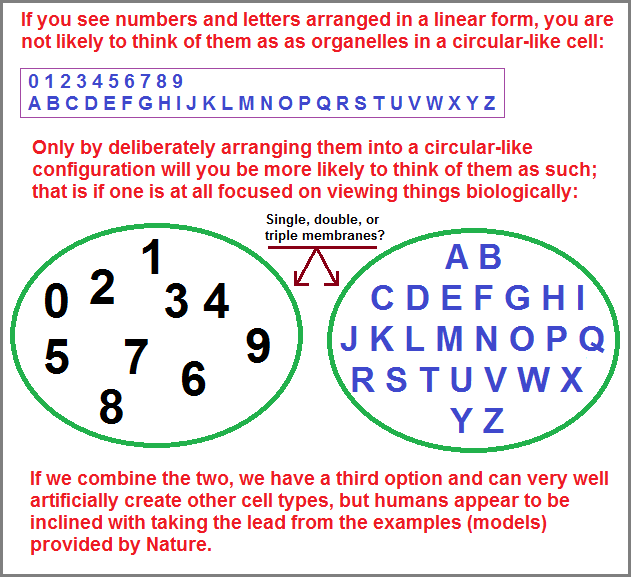
Both numbers and letters are languages we customarily place into a standardized sequential order (form of hybridization) and accommodate our thinking to such a design. Alternatively described: A language is a crowd (community, group, etc...) of words... since numbers too are spoken of as words. No matter how large or complex one thinks to create a given crowd or community (such as a computer language), we are using the same fundamental parts because we think there are no other fundamentals to find and therefore reject any alternative idea; as well expect everyone to tow-the-line of our belief system. Alternative ideas which do not kowtow to conventions, may be viewed as an anomaly. Each generation of people are confronted by sub-cultures who adopt a different language we might otherwise label as slang, jargon, vernacular, idiom, pidgin, etc... Words and numbers comprise two dominant languages used the world over, coupled with perception and interpretation for other types of languages denoted by various labels such as the different behaviors of activity humans are engaged in. (Music, crafts, dancing, running, swimming, cooking, etc...)
To me, the paragraph might as well have been taken out of a philosophy, mathematics, engineering, or other textbook, since all of them have liquidity, solidity, and a gaseousness... if not being 'plasmatic' at time. It also reads as a military and football strategy, if not a primer lesson in Economics. The "two" sides of a membrane are easily seen as a dichotomy, battle ground "theater" or scrimmage line. No less the remark about a plateau and concentration levels. The more imaginative one is, the greater the landscape(s) of possible viewing in one's contemplations.
Recent work in genetics, archeology, and linguistics indicates that all behaviorally modern humans share a recent common origin. The date involved is often identified with the sudden appearance, roughly 50,000 years ago, of strikingly modern behavior in the form of more sophisticated tools as well as painting, sculpture, and engraving. This new Upper Paleolithic culture differed dramatically from the Mousterian culture of the anatomically modern humans from whom the behaviorally modern humans emerged. The cause of this abrupt change has been attributed to the appearance of fully modern human language, and this is a plausible conjecture. With regard to language, Bengtson and Ruhlen have presented evidence that suggests that all or almost all attested human languages share a common origin. That origin need not necessarily refer all of the way back to the time when behaviorally modern humans emerged and peopled the Old World. There could have been a "bottleneck" effect at a much later time, with a single language spoken then being ancestral to all or most attested languages. If that is so, then that ancestral language, like nearly all modern languages, must have had a dominant ordering of the subject (S), verb (V), and object (O) in simple declarative sentences such as "the man (S) killed (V) the bear (O)." One should note that there is great variation in the rigidity of the basic word order in different languages, in part due to the fact that the syntactic functions of subject and object are often marked on the noun, as in Russian, which permits all six possible orders to yield grammatical sentences. Nonetheless, the basic word order of Russian is clearly SVO, and the other orders reflect special emphasis or other pragmatic factors. Australian languages, in particular, are known for their extremely free word order, and it has been claimed that some of those languages have no basic order. Still, as we shall see, the basic word order reported for most Australian languages is normally SOV, although other orders are also found...
Greenberg noted that of the six possible orders, only three are commonly found: SOV, SVO, and VSO. The great insight of Greenberg's paper, however, was not just an inventory of existing types—which obviously was long overdue—but the recognition that there were strong correlations between what seemed to be unrelated syntactic structures...
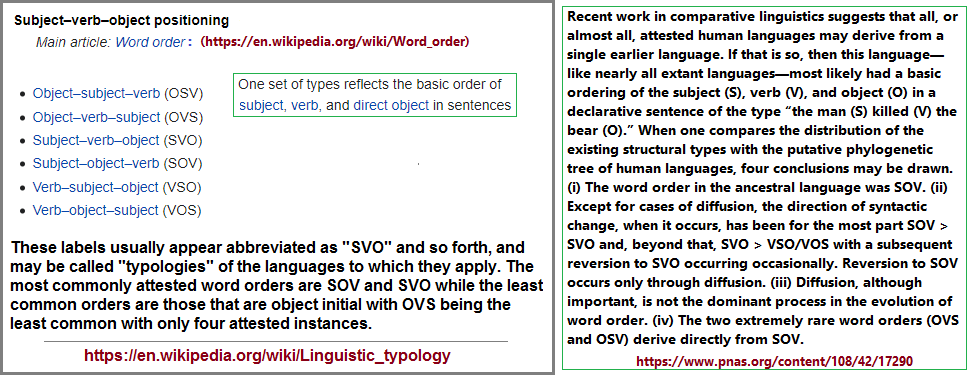
How does word Order work? The seven word orders by Thomas Moore Devlin, March 18, 2021
- Subject-Object-Verb (SOV), Percentage Of Languages: 41%, If English Used SOV: "I Sam saw."
- Subject-Verb-Object (SVO), Percentage Of Languages: 35%, If English Used SVO: "I saw Sam."
- Verb-Subject-Object (VSO), Percentage Of Languages: 7%, If English Used VSO: "Saw I Sam."
- Verb-Object-Subject (VOS), Percentage Of Languages: 2%, If English Used VOS: Saw Sam I.
- Object-Verb-Subject (OVS), Percentage Of Languages: <1%, If English Used OVS: Sam saw I.
- Object-Subject-Verb (OSV), Percentage Of Languages: <1%, If English Used OSV: Sam I saw.
- Free Word Order, Percentage Of Languages: 13.7%
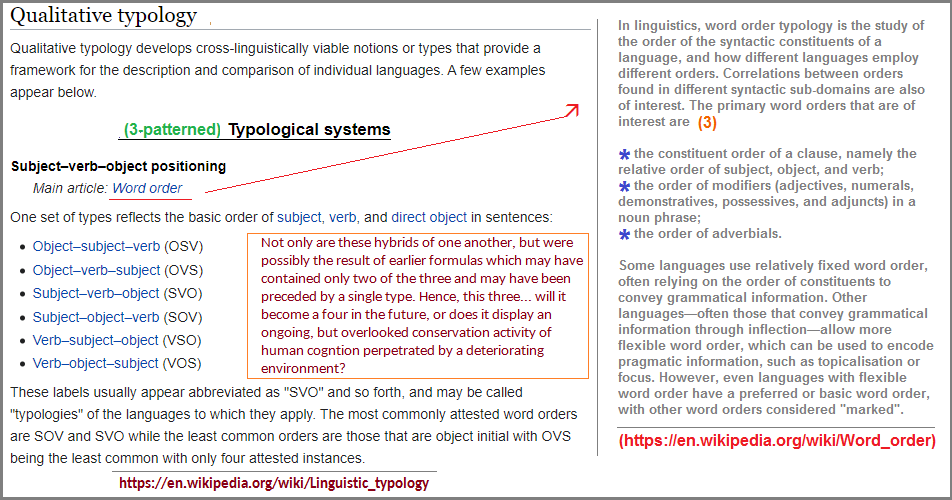
The further we recede into time, let us consider instead of a three-patterned S-O-V, there were only two of these such as an object and verb rendering the above sentence as "Sam Saw" or "Saw Sam". Even further back in time let us consider there was only one used such as "Sam". I am not saying this is how it was, but that there was some pattern-of-two which preceded the three and a single which preceded the double. What then came before the one and may follow the three, unless the incremental deterioration of the planet will force us to further condense, symbolize and abbreviate?
In the presence of a representation of Word Order, I can't help myself but digress to making a correlation with Mathematics and its convention of using an Order of Operations such as PEMDAS (though I learned it as PEDMAS many decades ago):
PEMDAS is an acronym used to mention the order of operations to be followed while solving expressions having multiple operations. PEMDAS stands for P- Parentheses, E- Exponents, M- Multiplication, D- Division, A- Addition, and S- Subtraction. There are different acronyms used for the order of operations in different countries. For example, in Canada, the order of operations is stated as BEDMAS (Brackets, Exponents, Division, Multiplication, Addition, and Subtraction). Some people prefer to say BODMAS (B- Brackets, O- Order or Off), while few others call it GEMDAS (G- Grouping).
It should be referenced that, in speaking, we might well break up the six letters into two groups by way of articulating the overall grouping as "PEM-DAS" (or PED-MAS). We see this same thing occurring in genetics when referencing DNA and RNA, by which I mean we will differentiate the first three of each as being the same (A-adenosine, C-cytosine, G-guanine), and the use the single letter T designate DNA and the single letter U to designate RNA. This, let us say... inclination to use groups-of-three has been mentioned in the case of the U.S. Social security numbers, to which I can add the usage of a recurring "three" based stratification in mathematics when we adhere to a place-value system:
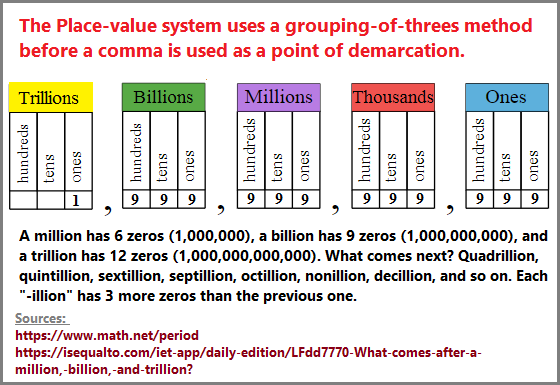
If we go outside the convention of providing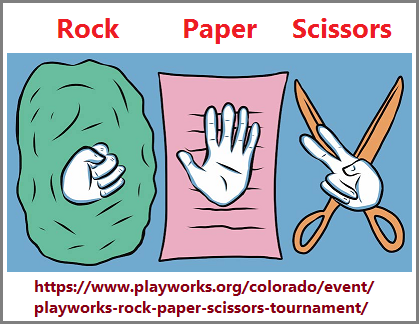 only certain kinds of examples typically used when discussing serious subjects, we can add references of human
cognition being used in the area of gaming, which are part of gaming theory. What come to mind in association with the usage of a "three" theme are items like
the Three Shells game (though, apparently, the word "shell" is not pluralized with an "s" in most
accounts.) To this we can add the idea of a numbers racket (Numbers game), where historically, three
numbers were used and not the multi-many used by lottery systems today. The old numbers racket was considered to be illegal since the government did not get its
share of the collected revenues, such as in the form of taxes. Since so-called modern numbers rackets called lotteries do provide the government with a portion
of the previously designated ill-gotten gains, numbers rackets, labeled as lotteries, have taken on a legitimate image, though many people swear they are just as
rigged as any gaming enterprise. Along with the three-shells game can be added the Three Card Monte
and the Rock, Paper, Scissors betting game, even if money is not used to indicated a win. And
no less, let me include the Win- Place- Show of Horse betting as another variation of this
same "three" illustrating a specific order and placement into a series with its convention of appearance and associated behavioral activity noted at any race
track.
only certain kinds of examples typically used when discussing serious subjects, we can add references of human
cognition being used in the area of gaming, which are part of gaming theory. What come to mind in association with the usage of a "three" theme are items like
the Three Shells game (though, apparently, the word "shell" is not pluralized with an "s" in most
accounts.) To this we can add the idea of a numbers racket (Numbers game), where historically, three
numbers were used and not the multi-many used by lottery systems today. The old numbers racket was considered to be illegal since the government did not get its
share of the collected revenues, such as in the form of taxes. Since so-called modern numbers rackets called lotteries do provide the government with a portion
of the previously designated ill-gotten gains, numbers rackets, labeled as lotteries, have taken on a legitimate image, though many people swear they are just as
rigged as any gaming enterprise. Along with the three-shells game can be added the Three Card Monte
and the Rock, Paper, Scissors betting game, even if money is not used to indicated a win. And
no less, let me include the Win- Place- Show of Horse betting as another variation of this
same "three" illustrating a specific order and placement into a series with its convention of appearance and associated behavioral activity noted at any race
track.
While different acronyms might be used in different circumstances, they generally refer to the same basic order such as in the case of using an acronym to help one in remembering how to write a certain word. However, the fact that different people use different acronyms is a subject of human cognition not frequently discussed as a tool by which the human thinking processes might be accessed on some deeper level.
At present, students learn an order for performing math equations just as one uses the rules supplied in a pamphlet or booklet contained in a package housing a game board of one type of another. While this says nothing about the variations different people employ once (after) the general rules-of-play are understood, this taken-for-granted fact of activity needs to be accounted for in such a discussion amongst those who seek to develop a means for instructing mathematics in a better way. The fact that many of us do not adhere strictly to rules provided by a game manufacturer is a point of cognitive activity which needs to be addressed. In one sense because there are three initial steps and three later steps (by looking to correlate the "three" letters of Word Order); altering the arrangement can in fact alter the result of the equation, just as switching around the Subject, Object, Verb can create different meanings (or at least impressions) of what is being said, though the listener may think the comment odd, they nonetheless may arrive at the intended meaning of the speaker, at least in the usage of a short sentence. If we increase the length of the sentence just as we have more letters (operations) in larger equations, we may encounter situations in which the intended result is misinterpret between the person doing the equation and the one who constructed it, even if the person already knows what the actual quantity of a given consideration is. The equation being provided may not be presented in the language the person doing equations is familiar with because it is presented in an arrangement that is not conventional.
If a person counts their sheep (in one's yard, barn or attempts to get to sleep) which are not present for anyone else to count and conveys the count with squiggly lines but everyone else is used to being provided an account in dots, dashes, lines or some other means; the person giving the correct count in an uncommon way may be accused of lying when they actually aren't. If a child provides an answer to some numbers which are not individually treated sub-vocally as more familiar words associated with quantities, the expected result of an adult-minded teacher may view the absence of an expected answer as indicating a student is doing math wrongly, yet they are nonetheless engaging in mental activity in a correct manner that they are accustomed to because it is the learned order of operations their mind functions with relative to the environment where they spend most of their time, and not the short period of a classroom. It matters not that some students come to "get it" with respect to learning "how to do" mathematics in an expected way to get a good... passing grade, the fact is that more students do not get it means we as a society do not understanding mathematics as a cognitive process related to word order, to the extent we can devise a universally applicable method to help all students grasp mathematics, even simply forms, much less higher mathematics that they will never use in their future jobs which don't require such a type of thinking and indeed expect a different type of cognitive ordering of thoughts to be conveyed in activity where business orientations is the expected norm for conducting oneself in a money-hungry capitalistic society children are born into.
When it comes to Consonants and Vowels, we ask questions such as:
- How many consonants and vowels (and inter-mediators or transitionals) are there?
- Do consonants or vowels occur first in speech?
- Do all life forms use vowels and consonants (and/or intermediates)?
- Is there anything more basic to consonants and vowels? (Is there a "quark" equivalent?)
- Because speech and grammar are routinely described in terms of one, two, or three patterns, is this due to a recurrence of "threes" in the design of the human ear?
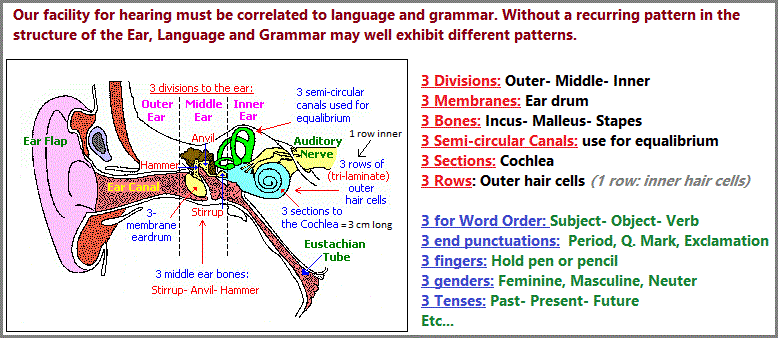
Language 3s page 1
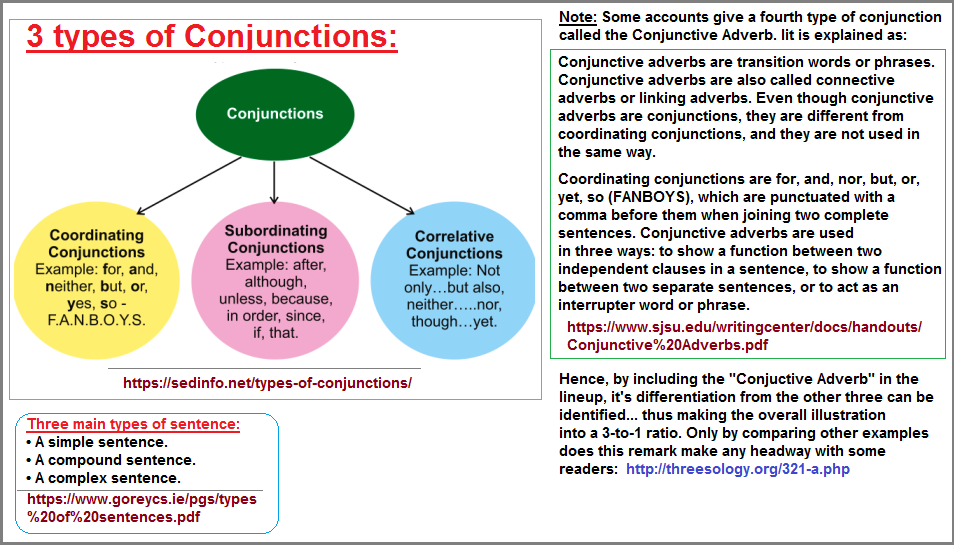
Human genetic and phenotypic diversity declines with distance from Africa, as predicted by a serial founder effect in which successive population bottlenecks during range expansion progressively reduce diversity, underpinning support for an African origin of modern humans. Recent work suggests that a similar founder effect may operate on human culture and language. Here I show that the number of phonemes used in a global sample of 504 languages is also clinal and fits a serial founder–effect model of expansion from an inferred origin in Africa. This result, which is not explained by more recent demographic history, local language diversity, or statistical non-independence within language families, points to parallel mechanisms shaping genetic and linguistic diversity and supports an African origin of modern human languages. (how many phonemes? by John Wells’s phonetic blog, Monday, 18 April 2011)
Languages grew from seed in Africa, study finds
A researcher analyzing the sounds in languages spoken around the world has detected an ancient signal that points to southern Africa as the place where modern human language originated.
The finding fits well with the evidence from fossil skulls and DNA that modern humans originated in Africa. It also implies, though does not prove, that modern language originated only once, an issue of considerable controversy among linguists.
The detection of such an ancient signal in language is surprising. Because words change so rapidly, many linguists think that languages cannot be traced very far back in time. The oldest language tree so far reconstructed, that of the Indo-European family, which includes English, goes back 9,000 years at most.
Quentin D. Atkinson, a biologist at the University of Auckland in New Zealand, has shattered this time barrier, if his claim is correct, by looking not at words but at phonemes — the consonants, vowels and tones that are the simplest elements of language. He has found a simple but striking pattern in some 500 languages spoken throughout the world: a language area uses fewer phonemes the farther that early humans had to travel from Africa to reach it.
Some of the click-using languages of Africa have more than 100 phonemes, whereas Hawaiian, toward the far end of the human migration route out of Africa, has only 13. English has 45 phonemes....
Another interesting hybridization of language studies is described in this article: You say Up, I say Yesterday (Can language shape how we think?) by Joan O’C. Hamilton, May/June 2010.
Excerpt:
...Lera Boroditsky's research suggests, for example, that the mechanics of using a language such as English, which tends to assign an agent to an action regardless of the agent's intent, also tends to more vividly imprint that agent in the speaker's memory. Other linguistic differences help young children in aboriginal cultures achieve powers of navigation that would confound a Harvard professor. She is amassing a body of intriguing and creative evidence that language influences how its speakers focus their attention, remember events and people, and think about the world around them. And these influences may provide insight to a given culture's conception of time, space, color or even justice...
When the origin and evolution of human language is discussed, there are a variety of suppositions. For example:
- Divine (God or gods) intervention
- Language "exploded" onto the human scene in an "all at once" appearance, perhaps similar to the "Cambrian Explosion" hypothesis for life.
- Language occurred by way of slow adaptive (evolutionary) processes.
- Language was influenced by a god-directed extra-terrestrial source.
- Language developed by way of Onomatopoeia (Such as sounds heard in one's environment or even one's body such as their stomach rumbling) 6 Early Theories About the Origin of Language by Arika Okrent
- The Bow-Wow theory of language development
- The idea that speech arose from people imitating the sounds that things make: Bow-wow, moo, baa, etc. Not likely, since very few things we talk about have characteristic sounds associated with them, and very few of our words sound anything at all like what they mean.
- A bow-wow theory is any of the theories by various scholars, including Jean-Jacques Rousseau and Johann Gottfried Herder, on the origins of human language. Bow-wow theories suggest that the first human languages developed as onomatopoeia, imitations of natural sounds. The name "bow-wow theory" was coined by Max Müller, a philologist who was critical of the notion. The bow-wow theory is largely discredited as an account of the origin of language, though some contemporary theories suggest that general imitative abilities may have played an important role in the evolution of language.
- The Pooh-Pooh theory (H.O.B. note: one might also describe a "Boo-Boo" theory since I have heard several mothers refer to a child's pain as a "Boo-Boo".)
- The idea that speech comes from the automatic vocal responses to pain, fear, surprise, or other emotions: a laugh, a shriek, a gasp. But plenty of animals make these kinds of sounds too, and they didn't end up with language.
- The Ding-Dong theory
- The idea that speech reflects some mystical resonance or harmony connected with things in the world. Unclear how one would investigate this.
- The Yo-He-Ho theory
- The idea that speech started with the rhythmic chants and grunts people used to coordinate their physical actions when they worked together. There's a pretty big difference between this kind of thing and what we do most of the time with language.
- The Ta-Ta theory (H.O.B. note: actually, I have heard the expression "Ta-Da" more than "Ta-Ta".)
- The idea that speech came from the use of tongue and mouth gestures to mimic manual gestures. For example, saying ta-ta is like waving goodbye with your tongue. But most of the things we talk about do not have characteristic gestures associated with them, much less gestures you can imitate with the tongue and mouth.
- The La-La theory
- The idea that speech emerged from the sounds of inspired playfulness, love, poetic sensibility, and song. This one is lovely, and no more or less likely than any of the others.
However... when thinking of humans imitating sounds, how are we to account for the recognizable (consonant/vowel) sounds of infant babbling? All too often in one's research we think only of describing the vocal sounds of those who are already adept at making word-sounds. And granted, that the physiology of infants is not fully developed with respect to the means by which words are made (larynx, etc...), can we not say that if an infant had a fully developed vocal tract the sounds of babbling might well be recognizable words? Let us then take the originating mechanism(s) for a babbled word and subject them to a fully grown speech creator. (Note: some people use the words "child" and "pediatric" inter-changeably, thereby making no explicit distinction between an infant and a child. The word "child" can be referenced in different contexts for different people related to infants or even adults, if a parent calls their children a child or even an adult child.)
While most of the foregoing ideas use a two-patterned phrase, this fact is overlooked and should be contrasted with the possibility that language development occurred in much the manner that language develops in "modern" infants into childhood, along a three-patterned one-word, two-word, multi-word divisioning. Hence, these old two-patterned phrases need to be identified as occurring in a time period by those researchers who had a dominant "two-patterned" orientation though there were exceptions occurring such as Georges Dumezil's tripartite ideology (also referred to as the Trifunctional Hypothesis). In other words, researchers are not typically identifying the recurring patterns of ideas being used by researchers of given eras as deduced by using a numerical system of identification, though we must include the notion that some authors may well have expressed ideas in the conventions of the eras to which they studied, even if they on a personal level thought otherwise. For example a researcher might write with a pattern-of-two to be consistent with their colleagues but think and keep personal notes which highlighted a usage of patterns-of-three or otherwise.
In this sense, one might write a two-patterned theory labeled as "Hye-Bye" and nonetheless record for themselves an observed three-patterned situation such as "Hi-Ho, Hi-Ho, it's off to work we go." Or in a more modern context as seen on a bumper sticker: "I Owe, I Owe, so it's off to work I go."
Concerning the idea of a "tripartite ideology" with reference to how old it may be, whether or not ancient users thereof were conscious of such a recurring usage:
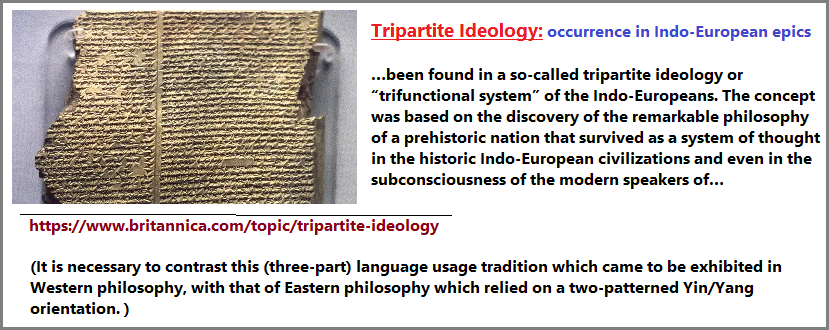
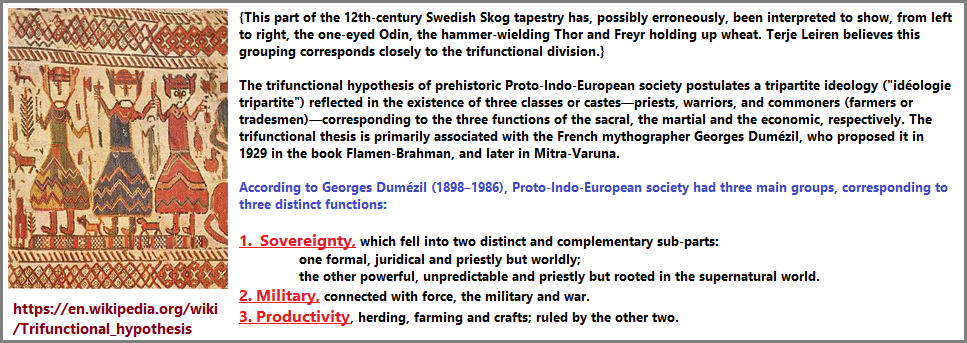
In stepping to the side of such a reference in order to denote an interesting correlation about language and three bear populations, we have the following:
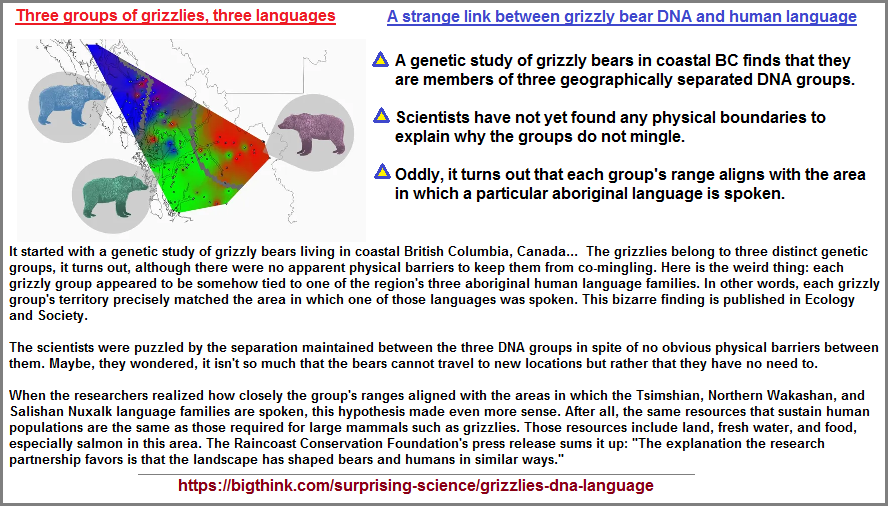
An interesting aspect about language is that it is seldom if every referred to as a shadow, even though it is often described as an incomplete image of one's thoughts and feelings. If we look at different types of shadows and recognize there are different "flavors", the idea of language being a shadow may be more easily understood, though the reverse of this might enter into the minds of some readers. While we may readily agree that mathematics is an abstraction, a symbolism of thought processing, we are not equally as quick to describe Mathematics as a shadow or bunches of shadows put together. By claiming language and mathematics as shadows, we must then consider that the human brain remains in a fledgling stage of development. Such shadows bring to mind the ideas of Plato's Cave and Sir Roger Bacon's Idols of the Mind. However, I am inclined to view Fairy Tales, Myths, Religion, Science, Politics, Music, Acting, Legends, technology, dreams, mental illness, law, etc., as different models of shadows.
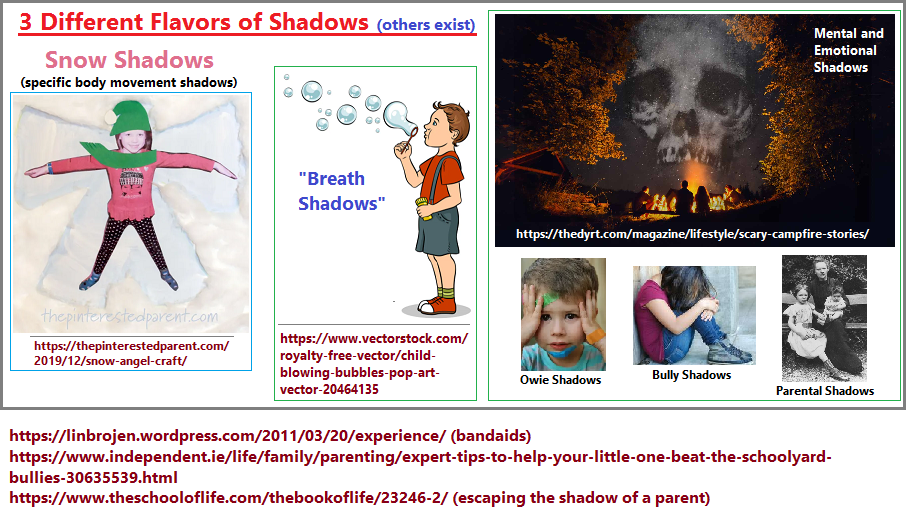
I shall take up the topic of Hybrids and Psychology on a forth-coming page.
Date of (series) Origination: Friday, 30th July, 2021... 6:38 AM
Date of Initial Posting (this page): Wednesday, 12th January, 2021... 10:45 AM